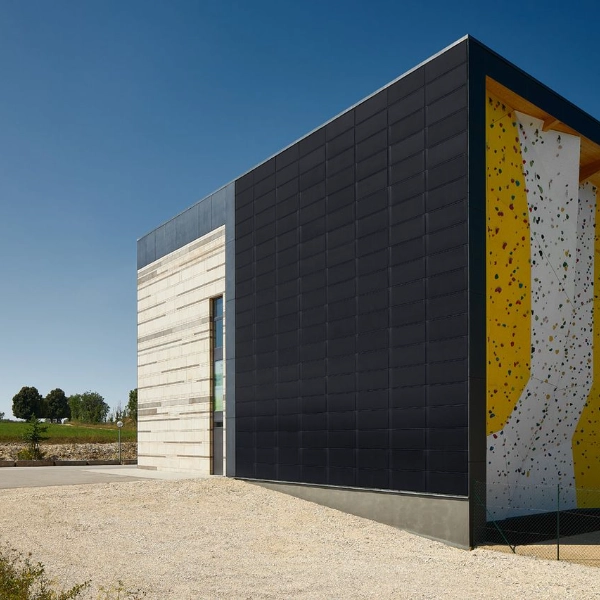With the advancement of global energy conservation, emission reduction and green building concepts, building integrated photovoltaic (BIPV) solar panels, as a technology that organically integrates photovoltaic power generation systems with building structures and appearance, are gradually becoming an important part of modern architectural design. BIPV can not only provide clean energy for buildings, but also optimize architectural aesthetics and improve the overall performance of buildings. This article will start from typical BIPV solar panel application cases around the world, and deeply explore its technical implementation and operation experience, providing reference and inspiration for related industries.
1. What is a BIPV solar panel?
BIPV solar panels refer to the integration of photovoltaic power generation modules directly into structural components such as roofs, curtain walls, skylights, balconies, and sunshades of buildings, replacing traditional building materials, and having power generation functions. It not only meets the structural requirements of buildings, but also can achieve on-site self-sufficiency of energy and reduce the carbon emissions of buildings.

2. Introduction to typical BIPV application cases around the world
EU Energy House in Frankfurt, Germany
Project background:
As a demonstration project for the EU to promote energy transformation, the EU Energy House integrates a high-performance BIPV curtain wall system and uses transparent photovoltaic glass to replace traditional curtain wall materials.
Technical features:
The application of transparent photovoltaic glass realizes the dual functions of lighting and power generation.
The thin-film solar cell technology is used, which is flexibly installed and takes into account the beauty of the building.
The intelligent energy management system realizes the dynamic balance and scheduling of electricity consumption.
Experience summary:
This project fully proves that the BIPV system can be used as a building exterior wall material, which does not affect the building lighting and can generate electricity efficiently, and is suitable for commercial buildings with high requirements for building appearance.
Apple Park, California, USA
Project background:
Apple Park is a world-renowned green technology park. The roof is fully paved with BIPV solar panels, and its huge roof area is used for photovoltaic power generation.
Technical features:
The use of high-efficiency monocrystalline silicon solar panels achieves an installed capacity of more than 17 megawatts.
The module design fits the roof shape perfectly, and the frameless structure is used to reduce shadow occlusion.
The system is integrated with building automation to monitor and optimize power generation efficiency in real time.
Experience summary:
The Apple Park case shows that BIPV technology can be applied to industrial and park buildings on a large scale, achieving energy self-sufficiency and significantly reducing operating energy consumption. It is a model of high-end green buildings.
Tokyo Big Sight, Japan
Project background:
The Tokyo Big Sight uses a BIPV solar roof system, demonstrating the possibility of integrating photovoltaics with large public buildings.
Technical features:
Colorful photovoltaic modules are used to enrich the visual effect of the building's exterior.
The system is combined with building energy consumption management to achieve partial self-power supply.
Seismic design is combined with photovoltaic components to ensure safety and stability.
Experience summary:
This project emphasizes the versatility of BIPV, which is not only an energy device, but also an architectural art design element, suitable for large public facilities and cultural buildings.
Shenzhen Bay Sports Center ("Spring Cocoon" Gymnasium), China
Project background:
The roof of Shenzhen Bay Sports Center integrates a large area of BIPV solar panels, which is a demonstration of green energy saving in large sports buildings in China.
Technical features:
The large-area photovoltaic curtain wall and roof combination meets the high energy consumption needs of sports venues.
The use of weather-resistant photovoltaic materials ensures long-term stable power generation.
Combined with the characteristics of the building structure, natural ventilation and photovoltaic systems complement each other.
Experience summary:
This case demonstrates the feasibility of BIPV in high-energy consumption, large-area buildings, emphasizing the durability of photovoltaic systems and the coordinated design with building functions.
3. Sharing of key experiences in the application of BIPV solar panels
High integration of design and architecture
Successful BIPV projects are inseparable from the close collaboration between architects and photovoltaic engineers. Photovoltaic system design should be included in the early stage of building design to ensure that photovoltaic modules are perfectly integrated with building structure, materials, and appearance, avoiding the high cost of later transformation.
Material selection and performance matching
Different building parts require different types of BIPV modules, for example:
Transparent or translucent photovoltaic glass is suitable for lighting curtain walls and skylights.
High-efficiency monocrystalline silicon modules are suitable for large-area installation on roofs.
Flexible thin-film photovoltaics are suitable for curved surfaces or complex shapes.
The weather resistance, wind pressure resistance and fire resistance of the material are key considerations and must meet local building codes.
Balance between power generation efficiency and architectural aesthetics
BIPV is not only a power generation device, but also an important element of the building's appearance. How to achieve diversified design of color, texture, and shape while ensuring power generation efficiency is the key to the success of the project.
Intelligent operation and maintenance and energy efficiency management
Equipped with an intelligent monitoring system, real-time detection of the operating status and power generation of photovoltaic modules will help timely maintenance and troubleshooting to ensure long-term stable operation of the system. At the same time, combined with the building's energy management system, power consumption optimization can be achieved.
Policy support and economic benefit evaluation
Countries generally have subsidy policies or tax incentives for BIPV projects. Making full use of policy advantages can significantly reduce investment costs. At the same time, a detailed economic benefit analysis should be conducted to consider the power generation income and maintenance costs within the life of the system to ensure the economic sustainability of the project.
Application cases of BIPV solar modules around the world demonstrate their wide applicability and huge development potential. Whether it is commercial buildings, public facilities, industrial parks or stadiums, BIPV can achieve a deep integration of buildings and energy, and promote the wave of green buildings and sustainable development.
As a professional BIPV solar module wholesaler, we deeply understand the important role of building-integrated photovoltaic systems in green buildings. With a rich product line and mature technical support, we provide customers with diversified and high-performance BIPV solutions, covering transparent photovoltaic glass, flexible thin-film modules and high-efficiency monocrystalline silicon modules to meet different architectural design needs. We not only focus on product quality, but also are committed to assisting architectural designers and developers to achieve the perfect integration of photovoltaics and architecture, and improve architectural aesthetics and energy efficiency. At the same time, with a deep understanding of typical application cases around the world, we are able to provide customers with professional technical consulting and project support to help them achieve success in energy conservation, emission reduction and sustainable development.
www.fgnexsolar.com
Wuxi Fgnex Technology Co., Ltd.


